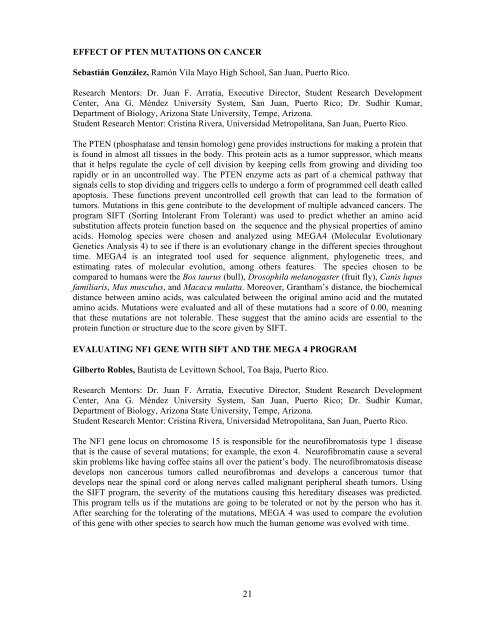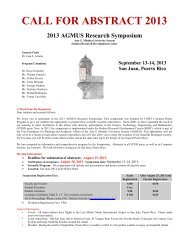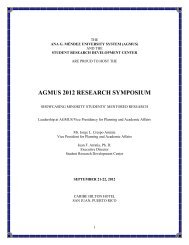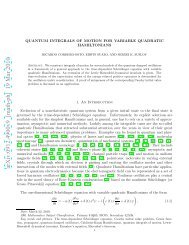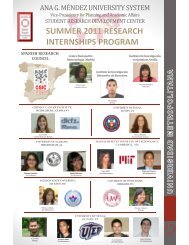WINTER 2008 PRE-COLLEGE RESEARCH SYMPOSIUM - Student ...
WINTER 2008 PRE-COLLEGE RESEARCH SYMPOSIUM - Student ...
WINTER 2008 PRE-COLLEGE RESEARCH SYMPOSIUM - Student ...
You also want an ePaper? Increase the reach of your titles
YUMPU automatically turns print PDFs into web optimized ePapers that Google loves.
EFFECT OF PTEN MUTATIONS ON CANCER<br />
Sebastián González, Ramón Vila Mayo High School, San Juan, Puerto Rico.<br />
Research Mentors: Dr. Juan F. Arratia, Executive Director, <strong>Student</strong> Research Development<br />
Center, Ana G. Méndez University System, San Juan, Puerto Rico; Dr. Sudhir Kumar,<br />
Department of Biology, Arizona State University, Tempe, Arizona.<br />
<strong>Student</strong> Research Mentor: Cristina Rivera, Universidad Metropolitana, San Juan, Puerto Rico.<br />
The PTEN (phosphatase and tensin homolog) gene provides instructions for making a protein that<br />
is found in almost all tissues in the body. This protein acts as a tumor suppressor, which means<br />
that it helps regulate the cycle of cell division by keeping cells from growing and dividing too<br />
rapidly or in an uncontrolled way. The PTEN enzyme acts as part of a chemical pathway that<br />
signals cells to stop dividing and triggers cells to undergo a form of programmed cell death called<br />
apoptosis. These functions prevent uncontrolled cell growth that can lead to the formation of<br />
tumors. Mutations in this gene contribute to the development of multiple advanced cancers. The<br />
program SIFT (Sorting Intolerant From Tolerant) was used to predict whether an amino acid<br />
substitution affects protein function based on the sequence and the physical properties of amino<br />
acids. Homolog species were chosen and analyzed using MEGA4 (Molecular Evolutionary<br />
Genetics Analysis 4) to see if there is an evolutionary change in the different species throughout<br />
time. MEGA4 is an integrated tool used for sequence alignment, phylogenetic trees, and<br />
estimating rates of molecular evolution, among others features. The species chosen to be<br />
compared to humans were the Bos taurus (bull), Drosophila melanogaster (fruit fly), Canis lupus<br />
familiaris, Mus musculus, and Macaca mulatta. Moreover, Grantham’s distance, the biochemical<br />
distance between amino acids, was calculated between the original amino acid and the mutated<br />
amino acids. Mutations were evaluated and all of these mutations had a score of 0.00, meaning<br />
that these mutations are not tolerable. These suggest that the amino acids are essential to the<br />
protein function or structure due to the score given by SIFT.<br />
EVALUATING NF1 GENE WITH SIFT AND THE MEGA 4 PROGRAM<br />
Gilberto Robles, Bautista de Levittown School, Toa Baja, Puerto Rico.<br />
Research Mentors: Dr. Juan F. Arratia, Executive Director, <strong>Student</strong> Research Development<br />
Center, Ana G. Méndez University System, San Juan, Puerto Rico; Dr. Sudhir Kumar,<br />
Department of Biology, Arizona State University, Tempe, Arizona.<br />
<strong>Student</strong> Research Mentor: Cristina Rivera, Universidad Metropolitana, San Juan, Puerto Rico.<br />
The NF1 gene locus on chromosome 15 is responsible for the neurofibromatosis type 1 disease<br />
that is the cause of several mutations; for example, the exon 4. Neurofibromatin cause a several<br />
skin problems like having coffee stains all over the patient’s body. The neurofibromatosis disease<br />
develops non cancerous tumors called neurofibromas and develops a cancerous tumor that<br />
develops near the spinal cord or along nerves called malignant peripheral sheath tumors. Using<br />
the SIFT program, the severity of the mutations causing this hereditary diseases was predicted.<br />
This program tells us if the mutations are going to be tolerated or not by the person who has it.<br />
After searching for the tolerating of the mutations, MEGA 4 was used to compare the evolution<br />
of this gene with other species to search how much the human genome was evolved with time.<br />
21


